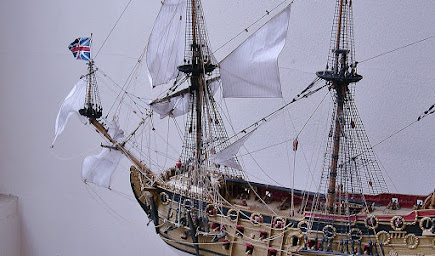This starboard overview show how beautiful and meticulous rigging can be when applied with careful assessment and patience. On such a small scale as this, it seem impossible to get the fine details (as such). But this can be achieved by working out the process in set stages -and scrutinizing each stage to make sure every possible line is applied. More is better if those lines can be fitted.
One of my greatest assets to period ships, especially miniatures, was my discovery of a chopstick method/system. With it, I was able to get difficult lines down to their belay points and finish with attractive coiling. Below, I apply this technique to the bow area where I secure the falls of the anchor bouys.
Rigging caught my attention early on during my youth, especially when I frequented the Boys Club in our city. There was a Clipper ship model that sat above the bowling lane that I admired. I wanted to know the history behind the ship and build.; but most important to me was how the rigging was applied. So for several years I would study it and asked the manager if I could stay behind when it was time for the building to close (for dinner hours).
It wasn't long before I spent my Saturdays at home watching pirate movies. I studied every aspect of those ships and zoned in on the rigging. What I missed in the first viewing, I made notes; later waiting for it to air again to get more information...Finally, my frequent library visits which started with my first book "The Ship" by author Bjorn Landstrom. That book, alone, opened up a new frontier of possibilities for me to excel as an artist-craftsman in the field of period ship models. His books (at that time) also assisted with my studies of various rigging lines.
We can never cease limiting our knowledge and/or abilities to improve and advance. Here, I am drawing a 'new' set of rigging plans based upon new discoveries of ignored processes. Since my first PRINCE of the 1980s, certain information weren't available -simply because home computers weren't a thing at that time. Now, with technology being what it is, there is a vast sea of information where one cannot be misinformed.
The above image is a perfect example of misinformation. What appears to be multiple lines on the left image is only a duplication of port and starboard belay points. Whereas the image on the left has many lines that have been researched and are not duplicated; but rather initialed 'p and s' which mean that this system of rigging will be featured port and starboard. Also, I was able to get 30 more lines rigged above the number count of the image at the left.
With better knowledge of the rigging process, it's now possible to customize the sails supporting the technique -leaving no guesswork. All lines are in place, ready to be led (in sequence) to their correct pins. The sail shown is the sprit sail.
Below, two views show the sprits and the effectiveness of motion in them...
Creating a sail (with attached rigging) can take up to three days, or more.
Here, the lines are clean and fall to their correct pins. Contemporary hobbyists and builders avoid complete rigging such as this because of either time constraints or inadequate knowledge of where the lines fall. So to avoid scrutiny, they just pass over the process and deem their pieces 'accurate'.
Such a word is baseless because it denotes totality and must be validated. I once embraced that, too; but realized as I matured in the art, the true premise for any 17th century ship is predicated on research. The more fact-based research, the better the model. Not so much the appearance, but the sweet evidence of the find...like the discovery of the Swedish ship Vasa.
The following six images will show updated rigging. It's been a complex and tedious affair, but well worth the effort relative to achieving the effect of true maritime -which is a science in and of itself...For instance, the Kensignton 'Science' Museum in London, England where the actual Prince (and other notable models) are housed is the result of painstaking research. This modified kit version is no exception.
There is not much more to say on this current blog except to leave you with these last two images in closing.
Any kit has promise to be something both breathtaking and extraordinary at the same time. It's really how one see the glass, whether it be half empty or half full. This is true with modelmaking. Laying eyes on these kits during my youth touched me in such a way to get the community involved. I was poor and didn't have the resources to get the 'right' materials to re-create the visions I knew were possible; not until I came across local business executives.
They had the money; I had the vision...
I pointed them to what I needed and they wrote the checks. These images are the result of what kindness can do; and that kindness extended forty years to 'today'. I had a vision to take three kits from a British manufacturer and mold them into miniature masterpieces -using Scripture of "a little here, a little there. Precept upon precept; line upon line"...and, I'm doing it.
I don't know what the final outcome will be when this final model of the Trilogy Series is finished. I can only hope these will be honored 'somewhere'. The main thing is that I'm finishing a four-decade old project that expands two centuries (1980 - 2021)...It doesn't get any better.
I hope to have this piece completed in several weeks; so until, keep viewing!
Fairwinds, and thank you.

















No comments:
Post a Comment